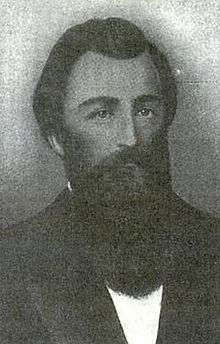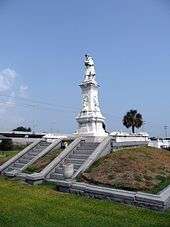William Bruce Mumford
William Bruce Mumford (December 5, 1819[1] – June 7, 1862) was a North Carolinian native and resident of New Orleans, who was hanged for tearing down a United States flag during the American Civil War.
William Bruce Mumford | |
|---|---|
 | |
| Born | December 5, 1819 North Carolina, U.S. |
| Died | June 7, 1862 (aged 42) Louisiana, U.S. |
| Known for | Being executed after tearing down an American flag during the U.S. Civil War. |
Flag incident
.svg.png)
On April 25, 1862, as Union Navy ships approached Confederate New Orleans, Commodore David Farragut ordered two officers to send a message to Mayor John T. Monroe requesting removal of Confederate flags from the local customhouse, mint and city hall and their replacement with U.S. flags. Monroe refused, claiming it was beyond his jurisdiction. On April 26, Capt. Henry W. Morris sent ashore Marines from the USS Pocahontas to raise the U.S. flag over the mint. Morris did so without any order from Farragut, who was still trying to receive an official surrender from the mayor.
As the Marines raised the flag, a number of locals gathered around in anger. The Marines told them that the Pocahontas would fire on anyone attempting to remove the flag. However, a group of seven individuals, including Mumford, decided to remove the flag from the mint. The Pocahontas fired and Mumford was injured by a flying piece of brick. With cheers from local onlookers, he carried the flag to the mayor at city hall, but onlookers tore at it as he walked, reducing it to a stub.
Trial and execution
Three days later Union Army Maj. Gen. Benjamin Butler, the commander of the Union ground forces, heard about the incident and decided to arrest and punish Mumford. When the Union Army occupied the city on May 1, Mumford was arrested and charged with "high crimes and misdemeanors against the laws of the United States, and the peace and dignity thereof and the Law Martial." On May 30, he was tried before a military tribunal and convicted, even though there was no clear attempt to determine whether the city was actually occupied when the event occurred.
On June 5, Butler issued the following Special Order No. 70:
William B. Mumford, a citizen of New Orleans, having been convicted before a military commission of treason and an overt act thereof, tearing down the United States flag from a public building of the United States, after said flag was placed there by Commodore Farragut, of the United States navy: It is ordered that he be executed according to sentence of said military commission on Saturday, June 7, inst., between the hours of 8 a.m. and 12 a.m. under the directions of the provost-marshal of the District of New Orleans, and for so doing this shall be his sufficient warrant.
On June 7, a little before noon, Mumford was taken to be hanged in the courtyard of the mint itself, a place that Butler had decided "according to the Spanish custom" would be the ideal place. Many people came to the spot, and Mumford was allowed to give a final speech in which he spoke of his patriotism for the Confederacy and his love for what he considered the true meaning of the U.S. flag, a symbol he had fought under in the Seminole Wars and the Mexican–American War.
Aftermath

After he was hanged, on June 18, Confederate Governor of Louisiana Thomas Overton Moore issued a statement declaring Mumford a hero and a model. Robert E. Lee demanded that Union Gen. Henry Wager Halleck explain how execution could have occurred for a crime committed before New Orleans was occupied. Confederate President Jefferson Davis issued a proclamation stating that Benjamin Butler should be considered a criminal and worthy of hanging. Later on Butler assisted Mumford's wife and helped her find a job in Washington.
Mumford was originally buried in a vault in Cypress Grove Cemetery, New Orleans. His remains were transferred to the Confederate Monument at Greenwood Cemetery, New Orleans, by the Ladies’ Confederate Memorial Association on January 11, 1950.
References
- "Particulars of the Execution of William B. Mumford for Hauling Down the United States Flag". New York Herald (9, 414). June 19, 1862. p. 2 – via Library of Congress.
Further reading
- Broadwater, Robert P., "William B. Mumford became a Southern hero for defying Union sailors in New Orleans", America's Civil War, November 2005, Vol. 18, Issue 5., p. 20.
- Roehl, Marjorie. "He was a rebel with a cause to the bitter end." The Times-Picayune [New Orleans] 10 May 1987: p. G11.